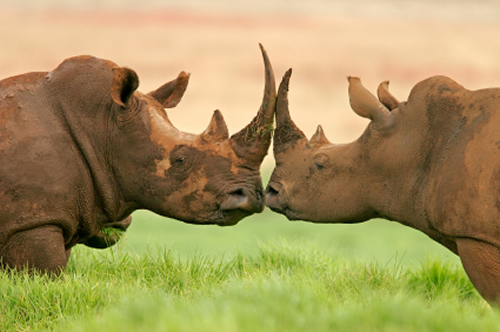by Ian Michler, courtesy of Conservation Action Trust, South Africa

It was Mark Twain who observed that “truth is stranger than fiction”, although some will suggest his shrewd comment on life was lifted directly from the line “Truth is always strange, stranger than fiction” contained in a poem by Lord Byron. Either way, both could well have had aspects of the current rhino crisis in mind when writing their respective pieces.
Who would ever have thought it true that an entire lobby group could get swept up in a cause that demands the world sets up a complete trading system for rhino horn, a product most accept has no intrinsic value whatsoever?
Ah, but I hear some saying, “don’t confuse truth with fact”, which of course has some merit, as truth dabbles in the abstract while fact should withstand all ambiguity. This leeway may also have had something to do with Twain’s explanation that “fiction is obliged to stick to possibilities; truth isn’t.”
And it’s also precisely why we are now faced with a flawed pro-trade paradigm, one I might add where some aspects are stranger than both truth and fiction.
Take the ‘market’ for horn and its price, for example. What is this all based on? It has never been a store of wealth, is not legal tender, and we know that imbibing horn has no medicinal value at all. It does not cure hangovers, cancer or reduce fevers, and it does not give superior sexual powers or increase body strength.
And we have little to no idea about the forces pushing both supply and demand, let alone what the prices paid on these ‘black’ markets are actually reflecting. Yet, exorbitant prices are being fixed on this animal body part.
Other factors, however, have become clearer. Recent research by various conservation agencies clearly shows how fiction is compounding the saga. Ignorance can no longer cloud our response as we now know that current consumption patterns are not based on age-old TCM beliefs and practices; something most assumed was the case when this crisis began. Instead, we are dealing with recently acquired social habits that come with a dose of misinformation, myth and nonsense with every milligram of powdered horn sold. Paid for with the spoils of recent economic successes experienced across Asia, the high cost seems to add a trendy boost to these flippant leisurely exploits.
This is vital information as it refutes the notion that demand-reduction should not or cannot be an essential strategy. And bear in mind that with rhino horn, we are not dealing with addictive or maladaptive behaviour either. The good news is that successes are being achieved: China and various visionary conservation agencies have reduced the consumption of shark fin soup by 70% in a short period and this is what a spokesperson for TRAFFIC in Japan had to say about ivory consumption in that country. “There is some demand in Japan for ivory, although it is a lot less than in the past…Younger consumers are not interested in buying anything made of ivory and we are looking into the precise reasons for that now…But we believe that enforcement of the law after CITES was signed and efforts to raise public awareness by the government, NGOs and environmental groups have all played a part.”
But what’s more, and here is the crunch, these inconsiderate actions are driving criminal activity that in turn is pushing one of our continent’s most iconic species towards extinction. These are all facts held to be true by nearly everyone battling to keep rhino alive, as well as most of us that are not Asian. How and why then does one alter this truth to accommodate a perpetuation of the misinformation and pure nonsense being pedalled? Are we not compelled by logic, good old common sense and integrity to stop the fraud?
And this leads to another fictional aspect to the crisis: the notion that keeping and breeding rhino in farm enclosures to harvest their horns is a conservation story. Nothing could be further from the truth. By all means, involve all constituencies committed to conserving rhinos, but be aware of vested interests tagging their long position in rhino horn into the cause as it may just end up damaging South Africa’s case.
This flawed paradigm is not the only compelling reason to refute trade. Let’s for the moment stay with the notion that it could be an option. Given that the current law clearly states trading in rhino horn is illegal, the onus then is firmly on any pro-trade analysis to show conclusively that their models will dramatically reduce the poaching and be a significant contributor to biodiversity conservation if the status is changed. And this it would seem cannot be done. While those of us with a modicum of economic knowledge and trading sense have already poked at the holes and exposed some of the vagaries, the more serious critical analysis that is starting to appear is undermining the entire basis of the pro-trade modelling. Simplistic and full of suitable assumptions, it fails to take into account a number of crucial factors around supply, demand, pricing and competition. And this is before we consider the strong probability that the CITES sanctioned sales of ivory in 1999 and 2008 have been a major trigger to the massive surge in elephant poaching across the continent, which threatens the very survival of this species in many African countries.
Unsound analysis based on sweeping assumptions is likely to result in poor decision-making with severe consequences for rhino and elephant populations. If ever the authorities should be considering the ‘precautionary principle’ in conservation, then the trade issue is it.
These reservations and risks are sound and logical reasons to instead support a multi-faceted approach for both the elephant and rhino crises that focus on the following: demand reduction across all Asian nations; improving policing and prosecution both in Africa and in Asia; enhanced protection for the species, and dealing with the poverty pressures and disempowerment issues that drive the poachers.
I also firmly believe that these battles cannot be fought or won on this continent alone: these crises are as much international ones as they are African. Lobbying the international community to become actively involved may well in the long term be the most vital action of all. They have the funds to rally the global conservation community, the technology and experience to assist with ground measures, and the political clout to coerce Vietnam and China into killing both trade and demand.
And recent developments across numerous fronts allow for some optimism that headway is gathering momentum. We have seen the USA, France, China and the Philippines crush ivory stockpiles within the last while, and then last week as part of their new National Strategy for Combating Wildlife Trafficking, the USA topped that by announcing a complete ban on the trade in ivory products. Other initiatives include the European Parliament calling on member states to destroy their ivory stockpiles and ban the trade in ivory, and world-renowned conservationist Jane Goodall has emphatically stated her opposition to trade.
These are strong messages and indicate a growing international groundswell against the trade speculators. However, there now needs to be one further step: the destruction of rhino horn stockpiles.
The most recent event may well be the most significant, and for reasons beyond the obvious. On 13 February, 46 nations from around the world and the EU itself signed up to the London Conference on the Illegal Wildlife Trade. Committing to co-ordinated political action, a principal component of the agreement seeks to eradicate both the demand and supply sides of illegal products wherever in the world these occur. It was a prominent conference hosted by the British PM, Prince Charles and Prince William with a wide scope and a list of worthy contributors. Given the urgency of what’s at stake, one would have thought it a recipe to attract the leading players and most of the African states affected by the poaching. And yes, most did participate, but the fact is one key player was conspicuously absent: South Africa did not attend! Why were we not represented as a country?
The opening of Parliament would excuse some, but surely amongst the hundreds of officials involved in our rhino poaching crisis, was there not a single candidate available to attend such a crucial forum? They will have their own truth, but as we have already established, this can be stranger than fiction.
It’s an extremely perplexing and worrying state of affairs and questions must be asked of the South African government’s vision, will and agenda. One can only hope this is not the beginning of the country’s isolation in this whole affair.
Ian Michler has spent the last 24 years working as a specialist guide, safari operator, photo-journalist and consultant across Africa, including a stint of 13 years based in the Okavango Delta, Botswana. His writing covers topics on conservation, wildlife management, ecotourism, and the environment in general, and he has been a regular contributor, columnist and blogger for Africa Geographic over the past two decades. Ian is a member of the International League of Conservation Writers and is the author and photographer of seven natural history and travel books on Africa. Prior to his life in the wilderness, he spent eight years practicing as a stockbroker in Cape Town and Johannesburg. He currently lives along the Garden Route where he runs Invent Africa, an inbound safari company that takes guests to 15 countries across Africa.




